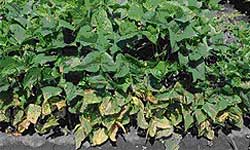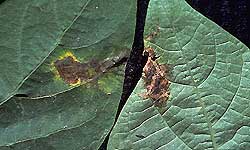Common blight of beans
Common blight is caused by the bacterium Xanthomonas axonopodis pv. phaseoli (formerly Xanthomonas campestris pv. phaseoli). It occurs where beans are grown worldwide.
The occurrence of common blight in Victoria is sporadic and it's now considered of moderate importance. When it occurs it's very destructive and can cause major losses.
It infects:
- foliage
- pods
- seed
- stems.
Host plants
The disease can affect:
- French bean
- runner bean
- pea
- garden lupin
- cowpea
- mung bean.
Symptoms of common blight
The following symptoms can indicate common blight.

On leaves:
- water soaked, often angular shaped spots on leaves
- these gradually grow to form large-brown spots of dead tissue, often surrounded by a very narrow zone of yellow tissue
- spots can form at the margins and interveinal regions
- in severe infections, the plant appears burnt and dead leaves remain attached.

On pods:
- spots are generally circular, slightly sunken, water-soaked and dark green in colour
- as spots age they turn dark red-brown in colour and under extremely humid conditions are covered with bacterial ooze.
On stems:
- water soaked spots turn red-brown in colour, generally without a a yellow margin
- stems may be girdled, leading to wilting
- stem spots are uncommon.
On seed:
- infection is more obvious on white seed varieties compared with dark seeded varieties
- yellow or brown-coloured spots on seed
- seed may be shrivelled and show poor germination.
Symptoms of common blight appear similar to halo blight, but halo blight has leaf spots with large, pale yellow margins.
Controlling common blight
To control common blight:
- use disease-free seed
- plant tolerant or resistant cultivars
- use a crop rotation of 2 or more years between bean crops
- eliminate alternate hosts such as volunteer beans and weeds
- use a registered bactericide spray if weather conditions favor disease development
- avoid overhead irrigation.
Disease cycle
Bacteria enter plants through wounds, such as those caused insects, machinery or climate, or through natural openings. It takes 10 to 14 days from initial infection for new bacteria to be released.
Spread of disease
Contaminated seed is the major means of dispersal of the bacterium.
It's also spread by:
- plant to plant contact, especially when wet
- water splash from rain or overhead irrigation.
It can be transported:
- in soil
- in irrigation water
- by insects, animals and people.
Environmental conditions
The disease develops best:
- in warm, humid weather
- with or without rain
- in temperatures of 28°C to 32°C.
Survival of bacterium
The bacterium can survive either inside the seed or on the seed surface. Tolerant varieties can harbour the bacterium.
It overwinters on infected plant debris, especially on residues near the soil surface.
The bacterium can also survive on the surface of volunteer beans and weeds without them showing any symptoms.
Reporting an unusual plant insect pest or disease
Report any unusual plant pest or disease immediately using our online reporting form or by calling the Exotic Plant Pest Hotline on 1800 084 881. Early reporting increases the chance of effective control and eradication.
Please take multiple good quality photos of the pests or damage to include in your report where possible, as this is essential for rapid pest and disease diagnosis and response.
Your report will be responded to by an experienced staff member, who may seek more information about the detection and explain next steps.
Report onlinePhoto credits
Figure 1 photo courtesy of Howard F. Schwartz.
Figure 2 photo courtesy of Howard F. Schwartz.
References
Persley, D., Cooke, T. and House, S. (2010). Diseases of vegetable crops in Australia. CSIRO Publishing, 292p.
Koike, S.T., Gladders, P. and Paulus, A.O. (2007). Vegetable diseases, a colour handbook. Mason Publishing, 448p.
Howard, F. S., James, R. S., Robert, H., and Robert, L. F. (2005) Compendium of Beans diseases. APS Publishing, 120p.
Xanthomonas axonopodis pv. phaseoli (bean blight). Crop Protection Compendium, Commonwealth Agricultural Bureau International. https://www.cabi.org/cpc/datasheet/56962. Last accessed 3 April 2020.